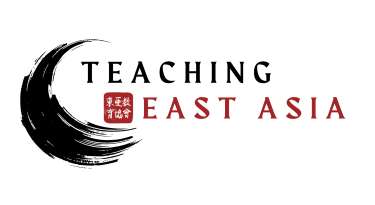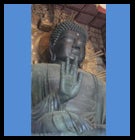Building Tōdai-ji
By Catherine Mein with Erica Gullickson
Lesson (pdf)
Handouts (pdf)
Assessment (pdf)
PowerPoint (ppt)
Lesson Demo (mp4)
Introduction:
In this lesson, students look at the decision to build the Great Buddha and the Tōdai-ji temple complex in Nara, examining whether the decision was a good use of resources. As they do so, they use both primary and secondary sources, text and visuals, to consider the connections between governance and Buddhist beliefs and some ways in which culture influenced how Emperor Shōmu sought to give a unified government legitimacy. As an assessment, students complete a decision tree evaluating the Emperor’s options.
This lesson is designed for use in a high school world history course, but middle school teachers may modify the reading and writing assignments to make the lesson workable with their students. The lesson could be included as part of a unit on the Silk Roads; as Buddhism traveled to Japan over those trade routes, so did some of the important guests at the temple’s dedication and the gifts given to the temple, which are held in the Shōsō-in, a large storehouse on the Tōdai-ji grounds. Students will need some understanding of the idea of “opportunity cost” in order to make well-reasoned decisions about how to use Nara Japan’s resources. You may also find it useful to explain to students the different types of economic resources—natural resources like copper and wood and human resources like labor and planning. In addition to looking at economic resources, students should focus on the religious, cultural, and political benefits of building a Buddhist temple like Tōdai-ji.
Objectives:
After completing this lesson, students will be able to:
- Recognize the resources and costs needed to build a Buddhist temple.
- Make connections between governance and Buddhist beliefs.
- Evaluate Emperor Shōmu’s decision to build Tōdai-ji.
Guiding Question:
- Was building the Great Buddha and its hall a good use of Nara Japan’s resources?
Standard and Guidelines:
World History Content Standards
- Era 4 (300-1000 CE), Standard 3: Major developments in East Asia and Southeast Asia in the era of the Tang dynasty, 600-900 CE.
- Standard 3A: The student understands China’s sustained political and cultural expansion in the Tang period.
- 7-12: Assess explanations for the spread and power of Buddhism in Tang China, Korea, and Japan.
- Standard 3B: The student understands developments in Japan, Korea, and Southeast Asia in an era of Chinese ascendancy.
- 7-12: Assess the patterns of borrowing and adaptation of Chinese culture in Japanese society from the 7th to the 11th century.
- 5-12: Describe the establishment of the imperial state in Japan and assess the role of the emperor in government.
AP® World History Curriculum Framework
- Period 3: Regional and Transregional Interactions, c. 600 C.E. to c. 1450
- Key Concept 3.2. Continuity and Innovation of State Forms and Their Interactions
- I. Empires collapsed and were reconstituted; in some regions new state forms emerged.
- A. Following the collapse of empires, most reconstituted governments, including the Byzantine Empire and the Chinese dynasties—Sui, Tang, and Song—combined traditional sources of power and legitimacy with innovations better suited to the current circumstances.
- C. Some states synthesized local and borrowed traditions.
Common Core State Standards: Grades 6-12 Literacy in History/Social Studies
- Integration of Knowledge and Ideas, CCSS.ELA-Literacy.RH.11-12.7: Integrate and evaluate multiple sources of information presented in diverse formats and media (e.g., visually, quantitatively, as well as in words) in order to address a question or solve a problem.
- Production and Distribution of Writing, CCSS.ELA-Literacy.WHST.11-12.4: Produce clear and coherent writing in which the development, organization, and style are appropriate to task, purpose, and audience.
- Research to Build and Present Knowledge, CCSS.ELA-Literacy.WHST.11-12.9: Draw evidence from informational texts to support analysis, reflection, and research.
Plan for Assessment:
Students will create a decision tree with at least three options for what Emperor Shōmu could have done. For each possible decision, students will identify the possible consequences or outcomes, both positive and negative. Students will provide a written explanation of which decision they think is best. The length of this written explanation should depend on the age of the students and the time frame for completing the lesson.
Be prepared to generate whole class lists in a form (chart paper, Word document, etc.) that can be retrieved and referred to by students in their final decision tree and writing assignment.
Time Required: Two 50-minute class periods. The lesson can be done in one class period if reading the three excerpts (Step 3 under Implementation) is assigned as homework the night before and the written assessment is assigned as homework the following night.
Materials:
Materials Provided
Handouts
- Emperor Shōmu’s Decision to Build Tōdai-ji (reading level: 10.8)
- Proclamation of the Emperor Shōmu on the Erection of the Great Buddha Image (reading level: 13.3)
- Description of Tōdai-ji’s Dedication Ceremony (reading level: 10.8)
PowerPoint
- Building Tōdai-ji
Assessment Tools
- Decision Tree Template
- Tōdai-ji Decision Tree Rubric
Online Resources
- Historic Monuments of Ancient Nara, UNESCO/NHK video clip, 2 min. 52 sec.
Other Materials
- Computer, projector, and internet connection
- Word document, chart paper, or other way to record class lists
Implementation:
Day 1
- Project the first photograph of the Great Buddha (Daibutsu) from the Building Tōdai-ji PowerPoint and explain that the statue, a Great Hall, and larger temple complex (Tōdai-ji) were built in the 8th century. Introduce the lesson’s central question, “Was building the Great Buddha and its hall a good use of Nara Japan’s resources?” As a whole class, discuss and record possible factors that should be considered in determining an answer to this question.
- Have students view (preferably twice) the Historic Monuments of Ancient Nara video online at http://whc.unesco.org/en/list/870/video. Debrief as a whole class using the following questions: What reasons were given for building the Great Buddha, its hall, and the Tōdai-ji temple complex? (For peace of the capital and nation, as a tool for national unity) What resources were needed? (Wood, clay, copper, fuel to melt the copper, equipment of various kinds, human labor) Record students’ answers in two separate lists.
- Have students read the three handouts, Emperor Shōmu’s Decision to Build Tōdai-ji, Proclamation of the Emperor Shōmu on the Erection of the Great Buddha Image, and Description of the Tōdai-ji’s Dedication Ceremony. Students should annotate the readings, noting reasons given for building the Great Buddha and its hall. Students should consider economic, political, cultural, and religious reasons.
- Have students share their findings. Add the reasons students identify to the list begun in Step 2. Discuss a tentative answer to the central question using only these sources. Inquire about discrepancies between the primary source “proclamation” and the secondary sources.
Day 2
- Show students the images of the Great Buddha and the Great Buddha Hall using the Building Tōdai-ji PowerPoint; share information from the PowerPoint Notes Pages with students. Have students generate a list of all the resources that would be needed to build the Buddha and hall; add these to the list begun the previous day.
- Split the class into three groups. Have each group re-read one of the three handouts, this time annotating for resources needed to build the Great Buddha and hall. Have students add to the “resources” list, providing evidence from the reading. Discuss the “opportunity cost” of building the Great Buddha and its hall. Ask: How would you answer the central question based on this information? (Answers will vary.)
- In groups of three or four students, have students discuss the central question, using all the available information. Each group should report out to the whole group on their discussion.
- For the concluding assessment, have students work in class to create a decision tree using the information from the various sources examined in the lesson. Using the Decision Tree assessment tool, students should identify at least three alternatives and should provide possible positive or negative consequences for each alternative.
- For homework, have students write an explanation of which decision they think is best. Students will need to clearly explain their reasoning for the alternative they would recommend. Their rationales should address the short- and long-term consequences as well as the opportunity costs of their alternative. Rationales should include economic, political, cultural, and religious consequences. Students should also explain why they did not choose either of the other options. Use the Tōdai-ji Decision Tree Rubric to establish expectations and for grading.
Extension:
Have students consider the building of Tōdai-ji from a commoner’s perspective by writing an “I am” poem as if they were conscripted to work on building the Great Buddha or its temple. For directions on “I am” poems, see the NCTE/IRA Read•Write•Think website.
Resources and References:
De Bary, Theodore, Donald Keene, George Tanabe, and Paul Varley, eds. Sources of Japanese Tradition from Earliest Times to 1600, Vol. 1, 2nd ed. New York: Columbia University, 2001.
Historic Monuments of Ancient Nara. Paris: UNESCO/NHK.
Huffman, James L. Japan in World History. New York: Oxford University Press, 2010.
Morimoto, Kousei, ed. Tōdai-ji. Samuel C. Morse, trans. Nara: Tōdai-ji, 2002.
Piggott, Joan R. Tōdaiji and the Nara Imperium. PhD dissertation. Stanford University. Ann Arbor: UMI, 1987. (Order No. 8723070)
The Program for Teaching East Asia at the University of Colorado gratefully acknowledges the support of the United States-Japan Foundation in the development of Cultural Encounters: Teaching Japan in World History.
Created 2015 Program for Teaching East Asia, University of Colorado. Permission is given to reproduce these lessons for classroom use only.

Cultural Encounters
- Ancient Japan
- Medieval Japan
- Unifying & Tokugawa Japan
- Meiji Japan
- Japan at War
- Contemporary Japan


